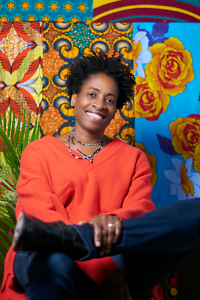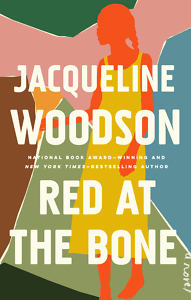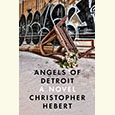I Am a Narrative
Novelist Jacqueline Woodson explores myriad facets of identity in Red at the Bone
“Look how beautifully black we are. And as we dance, I am not Melody who is sixteen, I am not my parents’ once illegitimate daughter — I am a narrative, someone’s almost forgotten story. Remembered.” This reflection appears near the beginning of Red at the Bone, Jacqueline Woodson’s second novel for adult readers, as Melody takes the dance floor at her coming-of-age ceremony. She is wearing a handmade white dress created for her mother, Iris, who was denied the opportunity to wear it. When she reached her own sixteenth birthday, Iris’ body was swollen with an unwanted pregnancy: baby Melody.

Woodson seizes this profound moment of inheritance as a stepping-off point into a rich meditation on identity and history through the lives of Melody, Iris, Melody’s father Aubrey, and Melody’s grandparents. Parallels and dichotomies abound: the daughter wearing the dress meant for the mother; the contrast between Iris’ educated, elite family and Aubrey’s single mother on public assistance; and the line between the nearly forgotten fires of the 1921 Tulsa Race Riot and the fires in lower Manhattan that riveted the entire world in September 2001, only a few short months after Melody’s ceremonial dance.
In 196 lyrical pages, Jacqueline Woodson delivers the kind of deep and resonant exploration of a plethora of aspects of 21st-century American life that might require 700-1,000 pages from a less artful storyteller. Red at the Bone is certainly a novel about African American experience, but it is also a novel of striking universality, touching issues of class, education, gender, parenthood, religion, sexuality, and above all, the contradictory nature of love. It’s a quiet book, pensive, subtly powerful, simultaneously readable and richly poetic, utterly unforgettable. Though written for adults, Red at the Bone is precisely the sort of book every adolescent should read to understand more fully the complexity of the world into which they are coming of age, just as Brown Girl Dreaming, Woodson’s celebrated memoir for young readers, should be read by any adult who wishes to recall the mysteries of childhood and understand how we all are shaped by them.
 Jacqueline Woodson has long been regarded as one of this country’s most gifted and important writers for young readers. Her more than two dozen books for children and teens, ranging from picture books to novels, have won countless awards and honors, and she has served as both the Poetry Foundation’s Young People’s Poet Laureate and the Library of Congress’ National Ambassador for Young People’s Literature.
Jacqueline Woodson has long been regarded as one of this country’s most gifted and important writers for young readers. Her more than two dozen books for children and teens, ranging from picture books to novels, have won countless awards and honors, and she has served as both the Poetry Foundation’s Young People’s Poet Laureate and the Library of Congress’ National Ambassador for Young People’s Literature.
We are all very fortunate that Woodson writes specifically for children; her work continues to influence legions of young readers to care about language, narrative, and character. She never panders, and her work is at once bravely honest about the hard facts of life and refreshingly hopeful and inspiring, despite the sometimes painful circumstances her characters must overcome.
But, as she has already proven with her first novel for adult readers, Another Brooklyn, a finalist for the 2016 National Book Award, the fact that Woodson writes primarily for young people should not belie her stature as a literary artist of the highest order. Perhaps the brilliance of Red at the Bone will offer critics and readers the opportunity to drop the qualifier. Jacqueline Woodson is one of this country’s most gifted and important novelists, period.

Ed Tarkington’s debut novel, Only Love Can Break Your Heart, was published by Algonquin Books in 2016. He lives in Nashville.


